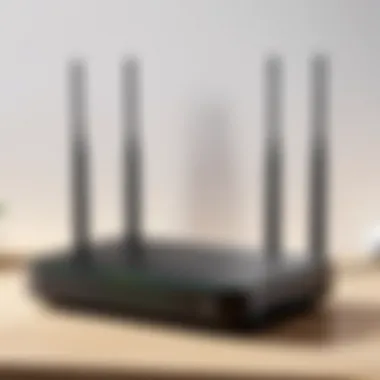Ultimate Guide to Long Range WiFi Repeaters


Intro
In today's interconnected world, having a reliable internet connection is vital. For many, WiFi is the gateway to online resources, whether for work, leisure, or communication. As we navigate through large homes, offices, or outdoor spaces, the challenge of maintaining a strong wireless signal becomes apparent. This necessity spurs the demand for long-range WiFi repeaters.
Long-range WiFi repeaters help extend the coverage of wireless networks. Adding such devices can boost signals to rooms that might otherwise have weak connectivity. This guide dives into the offerings available in this market, detailing both consumer and professional-grade options. We highlight key features to consider, performance analysis, and provide installation guidance, enabling informed decisions that meet unique connectivity needs.
Understanding Long Range WiFi Repeaters
Long-range WiFi repeaters have become essential devices in today's digital world. As more devices connect to the internet, having reliable wireless coverage is critical. This section delves into the nuances of long-range WiFi repeaters. Understanding their definition, purpose, and operating principles helps users make informed decisions when optimizing their home or office networks.
Definition and Purpose
A long-range WiFi repeater is a device that amplifies the existing WiFi signal, allowing it to reach further distances. Its primary purpose is to extend the coverage area of a wireless network, making it particularly useful in large homes, offices, or areas with physical obstructions. Without such devices, users may experience dead zones—areas where no signal is available. The enhanced connectivity can provide seamless internet access for various applications, from streaming media to online gaming.
The importance of long-range WiFi repeaters cannot be overstated, especially for businesses and remote work. These devices enable employees to work effectively from different locations within an office or from home. In residential settings, they ensure that every corner of a house enjoys internet access, accommodating the demands of smart home devices or multiple users.
In essence, the definition and purpose of long-range WiFi repeaters are to provide a solution for connectivity issues. Understanding how they work allows users to appreciate their value in modern networking scenarios.
How They Operate
Long-range WiFi repeaters operate by receiving the existing WiFi signal, amplifying it, and transmitting it to areas where the signal is weak or nonexistent. This process involves a few key components: an antenna, a receiver, and a transmitter. When the repeater is positioned correctly, it detects the incoming signal and provides a strong output signal to expand coverage.
Here are some essential aspects of how they function:
- Signal Reception: The repeater picks up the WiFi signal from the router.
- Signal Amplification: The device boosts the signal strength, ensuring it can reach further away.
- Signal Transmission: The enhanced signal is then broadcasted to other devices within its coverage area.
"Effective placement of a WiFi repeater is crucial. Optimal positioning ensures minimal signal interference and maximum coverage."
Users should consider the placement of their repeaters carefully, ensuring they are within the range of the original signal while also covering the desired areas. Additionally, the performance of these devices can be affected by walls, furniture, and electronic devices that cause interference. Knowledge of these operating principles aids users in optimizing their network setups and enhancing overall performance.
Importance of Long Range Connectivity
In today's digital landscape, long range connectivity has evolved beyond merely a luxury; it is now a fundamental requirement for both personal and professional environments. High-speed internet access is essential for communication, collaboration, and entertainment, underscoring the necessity of WiFi repeaters that can extend connectivity over larger distances. The ability to maintain quality signals across expansive areas ensures seamless access to information and services.
For homeowners, long range WiFi is crucial for engaging in activities like streaming, online gaming, and remote working. Families often find themselves using multiple devices concurrently. A reliable connection can prevent frustrating interruptions, enabling everyone to perform their tasks without compromise.
In the context of business, extended WiFi ranges help foster productivity and innovation. Companies increasingly rely on a multitude of devices connected to the internet for daily operations. Ensuring that every corner of the office has robust connectivity can facilitate real-time collaboration, video conferencing, and access to cloud resources. Thus, long range WiFi repeaters emerge as essential tools for creating a conducive work environment.
Additionally, long range connectivity plays a vital role in public spaces such as parks, libraries, and community centers. As these locations often serve large groups of people, having a strong WiFi signal throughout the area supports various activities. It also promotes digital inclusion, allowing all citizens to access information and services openly.
Key Takeaway: The importance of long range connectivity cannot be overstated. It enhances overall user experience and ensures that individuals, families, and organizations can thrive in an increasingly connected world.
Home Networking Requirements
Home networking has unique demands that require reliable and extensive connectivity. Homeowners want uninterrupted access to WiFi in every room, including outdoor spaces. Whether watching high-definition videos, participating in video calls, or gaming, a stable connection is crucial. Identifying areas of weak signal coverage can be the first step in addressing these issues.
Moreover, with a surge in smart home devices, the need for consistent WiFi is even more significant. Every device, from smart thermostats to security cameras, requires connectivity to function effectively. A reliable long range WiFi repeater can significantly improve the user experience, ensuring seamless interaction with multiple devices simultaneously.
Business and Remote Work Implications
The shift towards remote work has emphasized the importance of stable WiFi coverage in professional settings. As employees work from various locations, companies need to ensure that their staff can connect to work resources reliably. Without a robust network, productivity may decline, and employees could face challenges in performing their duties efficiently.


In addition, businesses that use cloud applications must prioritize connectivity. Fluctuating signals can hinder access to important files and services, obstructing workflow, and even affecting customer satisfaction. For business growth, investing in long range WiFi repeaters can lead to palpable gains in productivity and efficiency, making it a sound decision for many organizations.
Overall, understanding the importance of long range connectivity sets the stage for making informed decisions about solutions such as WiFi repeaters. This knowledge empowers both individuals and businesses to enhance their digital environments effectively.
Key Features to Look For
When selecting a long-range WiFi repeater, there are several key features to prioritize. Understanding these elements can greatly influence the effectiveness and reliability of your network connectivity. Therefore, this section focuses on essential characteristics, their advantages, and considerations to help you make an informed decision.
Range and Coverage
The range and coverage of a WiFi repeater are perhaps the most critical factors to consider. A good repeater should extend the wireless signal effectively across the intended area. This extension is often indicated in meters or feet. Look for models that offer strong amplification of signals in areas where the primary router’s signal may be weak or non-existent.
Additionally, consider environmental factors. Obstacles like walls, furniture, and large appliances can obstruct signals. A device that claims to cover a large area may not perform well if there are many physical barriers. Therefore, researching the typical coverage in real-world setups can provide insights into its effectiveness.
Performance Metrics
Performance metrics include bandwidth, latency, and signal stability. These metrics determine how well the repeater handles not just range but also speed and reliability. Each metric has its unique role in the overall functionality of a WiFi repeater.
Bandwidth
Bandwidth is a crucial aspect of network performance. It influences how much data can be transmitted simultaneously. A higher bandwidth often results in faster data transfer rates, which is essential for activities like streaming and gaming. Many long-range repeaters support dual-band technology, which allows devices to connect on both 2.4 GHz and 5 GHz frequencies.
This dual-band feature is particularly beneficial because it helps distribute network loads more effectively. While the 2.4 GHz band offers a longer range, the 5 GHz band provides faster speeds but has a shorter coverage distance. Balancing these two can significantly enhance performance.
Latency
Latency refers to the delay before data starts transferring after a request. It's expressed in milliseconds and can significantly affect the experience during online activities. Low latency is essential for real-time applications such as video conferencing and online gaming. A good repeater will minimize latency by having efficient routing and processing capabilities.
High latency can be detrimental. It may lead to frustrating delays and interruptions. When assessing a device’s specifications, consider those with lower latency for a more enjoyable and smooth online experience.
Signal Stability
Signal stability determines the consistency of your internet connection. A repeater should provide a steady signal without frequent drops. Signal drops can lead to disruptions during streaming and other online activities. Factors influencing stability include the repeater's quality, placement, and interference from other electronic devices.
It’s advisable to test signal strength before settling on a location for installation. Most repeaters have a way to visualize signal strength, helping you find the optimal position.
Compatibility with Devices
Compatibility is another factor to consider when choosing a WiFi repeater. Ensure that the repeater you are considering works with all your devices, including routers, smartphones, tablets, and smart home gadgets. Most modern repeaters support a wide range of protocols, like Wi-Fi 5 and Wi-Fi 6, improving their versatility.
Important Note: While most devices should work seamlessly, always check manufacturer specifications to ensure compatibility, especially with legacy devices that may not support newer network standards.
Ease of Installation
Ease of installation can save time and reduce frustrations during setup. Many repeaters come with user-friendly interfaces and app support. Some models even allow installation through a web interface that simplifies connecting to the main router. Look for devices that provide clear instructions and troubleshooting help. An intuitive setup process can save significant effort and time.
Security Features
Security features are essential in today’s digital landscape. A good long-range WiFi repeater should support advanced security protocols, such as WPA3, which offers robust encryption methods to protect your data. It’s also essential to check if the device includes features like guest networking to prevent unauthorized access. Furthermore, regular firmware updates can help address vulnerabilities, keeping your network safer.
In summary, selecting a WiFi repeater requires careful consideration of several key features. Focusing on range, performance metrics, compatibility, ease of installation, and security can help ensure a reliable and efficient wireless network. Making educated choices here can significantly enhance your connectivity and overall online experience.


Top Long Range WiFi Repeaters on the Market
Long range WiFi repeaters are critical tools for extending wireless coverage in both residential and commercial settings. The choice of a specific model can dramatically influence the quality of connectivity experienced by users. In this section, we will explore some of the top models available today, illustrating their features and functionalities to help users make informed decisions.
Comparison of Leading Models
When discussing the best long range WiFi repeaters, it is essential to consider their specifications, user ratings, and real-world performance. Below are comparisons of three leading models.
Model A: Specifications and Features
Model A stands out in the crowded market for its high-performance specifications. It operates on dual-band technology, allowing it to transmit effectively on both 2.4GHz and 5GHz channels. This flexibility can significantly enhance network speed and reliability over larger areas, a key consideration for users needing extensive coverage. A unique feature of Model A is its beamforming technology, which focuses the wireless signal directly towards connected devices. This results in improved range and stability compared to standard models. However, it may be somewhat less effective in environments with numerous physical barriers. The combination of robust hardware and advanced features makes Model A a popular choic for many tech-savvy homeowners and businesses alike.
Model B: Specifications and Features
Model B offers a noteworthy alternative with its emphasis on user-friendly design. It incorporates a simple setup process, which is beneficial for those who may not be technically inclined. This repeater also includes features like parental controls and guest network capabilities. One of its standout attributes is the ability to connect multiple devices without significant drops in performance. Nevertheless, while it excels in user convenience, it may lag behind in raw power when compared to higher-end models like Model A, especially in larger spaces.
Model C: Specifications and Features
Model C presents another distinctive option, primarily recognized for its extensive range capabilities. It is designed to provide coverage even in challenging areas, such as buildings with thick walls or multiple floors. One crucial aspect of Model C is its adaptive channel selection feature, which automatically chooses the optimal frequency to minimize interference from other networks. This can greatly enhance overall performance. However, some users report that the initial configuration can be more complex than other models. Despite this, its capabilities make it a favored choice among users needing exceptional range and flexibility.
User Reviews and Feedback
The analysis of user feedback on these models highlights important insights. Many users praise Model A for its outstanding connectivity but note that its installation is not as straightforward. Model B, on the other hand, receives accolades for ease of use but sometimes falls short in performance during peak usage. Feedback about Model C often reflects satisfaction due to its range, though potential users should be prepared for a steeper learning curve during setup. Choosing among these models will depend on individual preferences for range, ease of use, and network demands.
"Selecting the right long range WiFi repeater transcends mere specifications; it is about balancing personal needs with the technology’s capabilities."
Installation Guidelines
In understanding how to effectively utilize long-range WiFi repeaters, installation guidelines become crucial. A proper setup not only ensures optimal performance but also extends the lifespan of the device. Many potential issues arise from incorrect installations. Thus, comprehending what is necessary before and during the implementation can make a significant difference in how well the repeater functions.
When planning to install a long-range WiFi repeater, several elements need focused attention. Factors like location, device compatibility, and user requirements directly impact effectiveness. Poor placement can lead to signal interference and dead zones. Additionally, it is vital to recognize that different environments may require unique approaches to installation. In essence, preparation helps in avoiding common pitfalls, ensuring a smoother and more reliable connection afterward.
Pre-Installation Considerations
Before proceeding to install a long-range WiFi repeater, certain critical considerations should be assessed:
- Location: Identify the optimal location for the repeater. It should be placed halfway between the router and the area needing coverage. Ensure the location has access to power.
- Signal Strength: Use a device or app to assess the existing WiFi signal strength where the repeater will be placed. This measurement informs decisions about potential dead zones.
- Obstructions: Walls, furniture, and other barriers may signal attenuation. Thus, map out possible obstacles that may weaken signal connectivity.
- Compatibility: Confirm that the repeater is compatible with the existing router. Check for protocol standards like 802.11ac or 802.11n to ensure seamless interaction between devices.
Taking time for these pre-installation checks can save considerable effort later. Skipping these steps often leads to frustrations, such as recurrent disconnections or slow internet speeds.
Step-by-Step Setup Process
The setup process for a long-range WiFi repeater generally follows a systematic approach. Here’s a brief outline:
- Position the Repeater: As mentioned, place the repeater in the location determined during the pre-installation stage. Ensure it receives a good signal from the router without substantial obstructions.
- Connect to Power: Plug in the repeater to a power source. Wait for it to boot up.
- Access Configuration Interface: Most repeaters have a web interface. Connect a device to the repeater (either via Ethernet cable or WiFi). Open a web browser and enter the repeater’s IP address to access settings.
- Set Up the Repeater: Follow the on-screen instructions. This usually entails selecting the local network, inputting its password, and choosing whether to extend the network or create a new one.
- Save Settings: After confirming configuration details, save the settings. The repeater restarts to apply changes.
- Testing: After installation, connect devices to the repeater’s SSID. Run a speed test to verify performance.
This step-by-step procedure ensures each action is deliberate and effective. By following this guide, one can minimize connectivity problems.
Ensuring proper setup of long-range WiFi repeaters solidifies the foundation for an extended and stable online experience. This task, while straightforward, yields long-term benefits across all areas requiring wireless connectivity.
Troubleshooting Common Issues


Troubleshooting common issues with long-range WiFi repeaters is a crucial aspect of maintaining a stable and efficient wireless network. These devices, while effective in extending coverage, can face various complications that affect their performance. For IT professionals and tech enthusiasts, understanding how to identify and solve these issues is essential. Addressing connectivity problems not only enhances user experience but ensures that the investment in technology yields the desired return. When users become frustrated with slow or intermittent connections, it is important to have a strategy for diagnosing and resolving these problems efficiently.
Identifying Connectivity Problems
Identifying connectivity problems involves several key steps. First, check if the repeater itself is powered on and the indicators are functioning correctly. If the LEDs suggest that it is operational, next verify if the issue lies with the connection to the main router. A weak signal from the router is often the root cause of connectivity issues at the repeater.
Next, assess the distance between the repeater and the router. If they are too far apart, the signal could weaken significantly. In such cases, relocating the repeater closer to the router may be a solution.
Consider performing a speed test both at the router and the connected devices. This can help determine if the problem lies in the repeater or the broadband service itself. It is also valuable to review the settings on the repeater's interface. Ensure that the firmware is up-to-date, as outdated software can lead to various malfunctions. Using network analysis tools can further aid in diagnosing connectivity issues.
Performance Optimization Tips
Once connectivity problems have been identified, optimizing performance can elevate the user experience. Here are some effective tips to consider:
- Optimal Placement: Position the repeater in a central location between the router and the area needing service. Avoid placing it behind thick walls or near electronic appliances that might interfere with the signal.
- Firmware Updates: Regularly check for and apply firmware updates. These updates often include enhancements and bug fixes that improve performance.
- Frequency Band Selection: Utilize the dual-band feature, if available. Switching between the 2.4 GHz and 5 GHz bands may resolve performance issues, as different bands can have varying coverage capabilities.
- Network Congestion: If many devices are connected, consider upgrading to a higher bandwidth plan or limiting concurrent connections that can slow the network.
- Reset and Reconfigure: If all else fails, performing a factory reset on the repeater can clear any underlying issues. Following that, carefully reconfigure its settings to ensure optimal performance.
"Identifying and optimizing the performance of long-range WiFi repeaters is crucial for seamless connectivity, especially in larger environments."
By following these strategies, one can significantly improve the functionality of long-range WiFi repeaters, ensuring that they effectively meet the demands of modern connectivity.
Future of WiFi Repeater Technology
The future of WiFi repeater technology represents a critical area of development within wireless communication systems. As the demand for higher bandwidth and greater coverage increases, long-range WiFi repeaters must adapt to new challenges. These devices are vital in extending the reach of wireless networks, especially in environments where direct connections are difficult. Understanding the emerging trends and advancements in WiFi standards will shed light on how these technologies might evolve and impact users.
Emerging Trends
Several trends are shaping the future landscape of WiFi repeaters. Here are some significant ones:
- Mesh Networking: This technology eliminates dead zones by using multiple nodes that communicate with each other. Instead of a single source of WiFi, mesh networks distribute connectivity across multiple points, providing stable internet access throughout a coverage area.
- WiFi 6 and Beyond: The introduction of WiFi 6 has changed the performance expectations for routers and repeaters. Devices that support WiFi 6 can handle more devices simultaneously, offering improved speeds and efficiency. Future advancements, like WiFi 7, are expected to deliver even more significant enhancements.
- Smart Home Integration: Future WiFi repeaters may integrate seamlessly with smart home ecosystems. This allows them to not only extend WiFi coverage but also manage and optimize network performance based on device usage patterns.
- AI and Machine Learning: Implementing AI in WiFi technology can help optimize performance dynamically. These systems can learn from user behavior and automatically adjust settings to maximize efficiency and minimize interruptions.
Adapting to these trends will be essential for manufacturers. The development of features that enhance user experience will likely become a priority.
Impact of Advancements in WiFi Standards
The evolution of WiFi standards profoundly influences long-range repeater technology. Each new standard brings enhancements that can change how devices operate. For example:
- Improved Speeds and Capacity: As WiFi standards have evolved from 802.11n to 802.11ac and now 802.11ax (WiFi 6), maximum throughput has increased significantly. This directly enhances the effectiveness of repeaters, enabling them to deliver faster internet speeds over larger areas.
- Better Spectrum Efficiency: New standards improve frequency use. Devices can operate more effectively within crowded environments, reducing interference and improving connectivity reliability.
- Increased Security Protocols: As security remains a priority, advancements in WiFi protocols focus on enhancing encryption and authentication. Future repeaters will likely utilize more robust security measures to protect networks from emerging threats.
In summary, the future of WiFi repeater technology is aligned with ongoing advancements in wireless standards. By embracing these innovations, manufacturers can provide devices that meet the growing connectivity demands of consumers and businesses. The ability to deliver reliable and comprehensive coverage will be key to staying relevant in this market.
Ending
In this article, we explored the nuanced landscape of long-range WiFi repeaters. Understanding the functionality and purpose of these devices is crucial, as is recognizing their importance in both home and business networking environments.
Summarizing Key Insights
Long-range WiFi repeaters serve as critical tools in enhancing wireless connectivity. The key insights from our discussion include:
- Definition and Purpose: Long-range repeaters are designed to extend the coverage of WiFi networks, making them vital in larger spaces or areas with physical obstructions.
- Operational Mechanics: These devices receive existing WiFi signals and amplify them, ensuring that reliable internet access is maintained over greater distances.
- Selection Criteria: It is essential to consider factors like range, performance metrics, compatibility, installation ease, and security features when selecting a repeater.
- Market Analysis: We evaluated leading models and highlighted user feedback to offer a comprehensive view of top choices available today.
- Installation and Maintenance: Proper installation is key to achieving optimal performance, along with ongoing troubleshooting to address any connections issues.
The guide articulates a well-rounded understanding of available technology, enabling informed decisions.
Final Recommendations
When selecting a long-range WiFi repeater, consider the following recommendations:
- Assess Your Needs: Evaluate the layout of your home or office, and define coverage areas that require enhanced WiFi signal.
- Choose Compatible Devices: Prioritize repeaters that are compatible with your existing network equipment. This ensures seamless integration and performance.
- Focus on Advanced Features: Options that feature dual-band capabilities, advanced security protocols, or user-friendly interfaces should be given preference.
- Plan for Future Upgrades: As technology evolves, select devices that can adapt to future WiFi advancements, prolonging their relevance.
- Solicit User Feedback: Review insights from other users to gauge the real-world performance and reliability of your chosen model.
By adhering to these recommendations, IT professionals and tech enthusiasts alike will find that they can significantly enhance their networking environments, ensuring that optimal connectivity is achieved.



